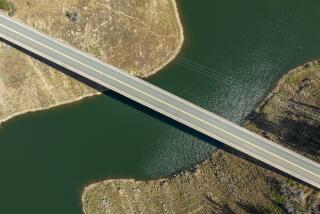California water agencies to urge regulators to ease drought restrictions

A number of California water districts are expected to urge state regulators to relax emergency water restrictions as rain and snow this winter have eased five years of drought.
- Share via
California water districts large and small are expected to urge regulators on Wednesday to toss out or significantly relax emergency drought orders requiring residents to take shorter showers and let their lawns turn brown.
Strict orders remain in place, despite significantly more rain and snow this winter flowing into California reservoirs, easing five years of drought, local water officials say.
Continuing to ask Californians to sustain “heroic water conservation efforts” that don’t reflect healthier water supplies today could erode the officials’ credibility with residents when they’re called upon next time to make sacrifices, David Bolland, special projects manager for the Assn. of California Water Agencies says in a letter to water regulators.
“It is time to end the State Water Board’s mandatory water-use restrictions statewide,” says Bolland, who represents hundreds of urban, commercial and agricultural water districts.
The State Water Resources Control Board on Wednesday is holding an informational workshop to chart the future of urban water conservation measures. Dozens of water districts wrote letters to the board, which could adopt change in May.
Nearly a year ago, Gov. Jerry Brown ordered California’s residents and businesses to conserve after calls for voluntary cutbacks failed to reap significant water savings in the state’s driest four-year period on record.
Residents statewide used 23.9% less water over the nine months ending in February under orders to use 25% less water compared to the same months in 2013.
Residents are now under orders to cut back through October by at least 20%.
Guiding a discussion of how new conservation orders should look, water regulators asked if each region of the state should be treated differently, given their individual water supplies and how each is recovering from drought.
Two High Sierra reservoirs that supply about 38,000 residents in Tuolumne County are expected to overflow, making the emergency regulations there “wholly unnecessary,” Thomas Haglund, general manager of the Tuolumne Utilities District, wrote to the board.
Other districts say that if the emergency order isn’t lifted, they should at least be eased to give them more credit for having invested in developing new sources of water and efficiency.
Tracy Quinn, a senior policy analyst for the Natural Resources Defense Council, in a letter submitted by several environmental organizations, cautioned against abandoning conservation measures in response to outcry from local districts.
There is no certainty of another wet winter to follow and much of the state remains in drought conditions, Quinn said. She added that some adjustment to the drought orders are warranted, but conservation should be a way of life for California.
“California’s water challenges are immense and extend far beyond the current drought,” Quinn wrote.
ALSO
3-year-old girl bitten by rattlesnake remains in critical condition
Major earthquake overdue in California’s Eastern Sierra, study finds
Homeless measures take center stage in Mayor Garcetti’s 2016 budget proposal
More to Read
Sign up for Essential California
The most important California stories and recommendations in your inbox every morning.
You may occasionally receive promotional content from the Los Angeles Times.










